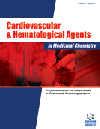- Home
- A-Z Publications
- Cardiovascular & Hematological Agents in Medicinal Chemistry (Formerly Current Medicinal Chemistry - Cardiovascular & Hematological Agents)
- Previous Issues
- Volume 21, Issue 3, 2023
Cardiovascular & Hematological Agents in Medicinal Chemistry (Formerly Current Medicinal Chemistry - Cardiovascular & Hematological Agents) - Volume 21, Issue 3, 2023
Volume 21, Issue 3, 2023
-
-
The Role of Human Platelet-rich Plasma to Enhance the Differentiation of Adipose-derived Mesenchymal Stem Cells into Cardiomyocyte: An Experimental Study
More LessBackground: Several studies have shown that adipose-derived mesenchymal stem cells (AMSCs) can differentiate into mesenchymal lineages, including cardiac cell types, but complete differentiation into cardiomyocytes is challenging. Unfortunately, the optimal method to maximize AMSCs differentiation has not yet been established. Platelet-rich plasma (PRP), which contains rich growth factors, is believed to stimulate stem Read More
-
-
-
Salvia aucheri Exhibits Antihypertensive Activity in Hypertensive Rats
More LessAuthors: Amine Azzane, Ayoub Amssayef and Mohamed EddouksAims: The present work aimed to assess the antihypertensive activity of Salvia aucheri. Background: Salvia aucheri (S. aucheri) is an aromatic and medicinal herb belonging to the Lamiaceae family. In Morocco, this plant is locally used for used to treat stomach, digestive disorders, rheumatism, and hypertension. Nevertheless, the effect of Salvia aucheri on hypertension has not yet been studied. Objective: The objective of this in Read More
-
-
-
Ammodaucus leucotrichus Acts as an Antihypertensive and Vasorelaxant Agent Through sGC and Prostaglandin Synthesis Pathways
More LessAuthors: Smail Amtaghri, Miloudia Slaoui and Mohamed EddouksBackground: Ammodaucus leucotrichus is a medicinal plant used in traditional medicine to treat various ailments, including hypertension. Aims: The study aimed to determine the antihypertensive activity of Ammodaucus leucotrichus. Objective: The study aimed to investigate the antihypertensive and vasorelaxant activities of the aqueous extract of Ammodaucus leucotrichus fruits (ALAE) in rats. Methods: ALAE wa Read More
-
-
-
Clinical Characteristics and Risk Factors for Bloodstream Infections in Children with Cancer: A Report from a Pediatric Hematology Oncology Unit
More LessBackground/Aim: Infections are a major cause of morbidity and mortality in children with haematologic malignancies and solid tumors as well as those undergoing hematopoietic stem cell transplantation (HSCT). The purpose of our study was to record the epidemiological characteristics and outcomes of bacteremias, focusing on pathogens, as well as risk factors and mortality rates in patients of a pediatric hematology-oncolo Read More
-
-
-
L-Tartaric Acid Exhibits Antihypertensive and Vasorelaxant Effects: The Possible Role of eNOS/NO/cGMP Pathways
More LessAuthors: Ayoub Amssayef, Ismail Bouadid and Mohamed EddouksAims: The aim of the study was to investigate the antihypertensive effect of L-Tartaric acid. Background: L-Tartaric acid (L-TA) is a well-known weak organic acid that naturally occurs in a wide range of fruits, most notably in grapes, tamarind, and citrus. Objective: The present study aimed to assess the effect of acute and subchronic administration of L-TA on blood pressure parameters in normotensive and hypertensive rats a Read More
-
-
-
Antihypertensive Effect of Euphorbia cheiradenia in Rats
More LessAuthors: Smail Amthaghri, Ayoub Amssayef, Miloudia Slaoui and Mohamed EddouksAims: The study aimed to investigate the effect of Euphorbia cheiradenia on blood pressure. Background: Euphorbia cheiradenia is a medicinal plant with several medicinal properties. Objective: This study aimed to study the vasorelaxant and antihypertensive capacity of the aqueous extract of Euphorbia cheiradenia (E. cheiradenia), and to evaluate its effect on angiotensinconverting enzyme 2 (ACE2). Methods: The antihyper Read More
-
-
-
Assessment of Circulating CCR6 Level in Acute Myocardial Infarction and its Association with Disease Severity
More LessBackground: Acute myocardial infarction (AMI) pathophysiology is mediated by systemic, intraplaque myocardial inflammatory processes that occur mainly due to coronary artery thrombosis in an atherosclerotic plaque area. The G-protein-coupled chemokine receptor (Ccr6) is displayed on the surface of many types of leukocytes, that have been found in atherosclerotic plaques. It is a novel mediator of inflammation and i Read More
-
-
-
Salvia miltiorrhiza Extract Prevents the Occurrence of Early Atherosclerosis in Apoe -/- Mice via TLR4/ NF-kB Pathway
More LessAuthors: Ruoyu Wu, Linqi Zhang, Hongjun Xu, Hongxu Chen, Wei Zhao, Yongjie Zhou, Luyang Zhou, Jiangli Wu and Shengjun AnObjective: Salvia miltiorrhiza (SM) contains four major aqueous active ingredients, which have been isolated, purified and identified as danshensu (DSS), salvianolic acid A (Sal-A), salvianolic acid B (Sal-B) and protocatechuic aldehyde (PAL), A mixture of these four ingredients is called SABP. Although aqueous extract from Salvia miltiorrhiza has been traditionally used to treat cardiovascular diseases, the efficacy and function Read More
-
Volumes & issues
-
Volume 23 (2025)
-
Volume 22 (2024)
-
Volume 21 (2023)
-
Volume 20 (2022)
-
Volume 19 (2021)
-
Volume 18 (2020)
-
Volume 2 (2020)
-
Volume 17 (2019)
-
Volume 16 (2018)
-
Volume 15 (2017)
-
Volume 14 (2016)
-
Volume 13 (2015)
-
Volume 12 (2014)
-
Volume 11 (2013)
-
Volume 10 (2012)
-
Volume 9 (2011)
-
Volume 8 (2010)
-
Volume 7 (2009)
-
Volume 6 (2008)
-
Volume 5 (2007)
-
Volume 4 (2006)
Most Read This Month
Article
content/journals/chamc
Journal
10
5
false
en


